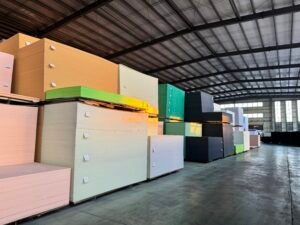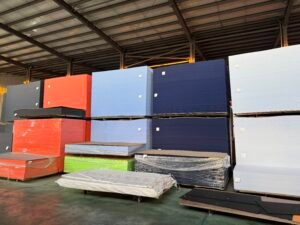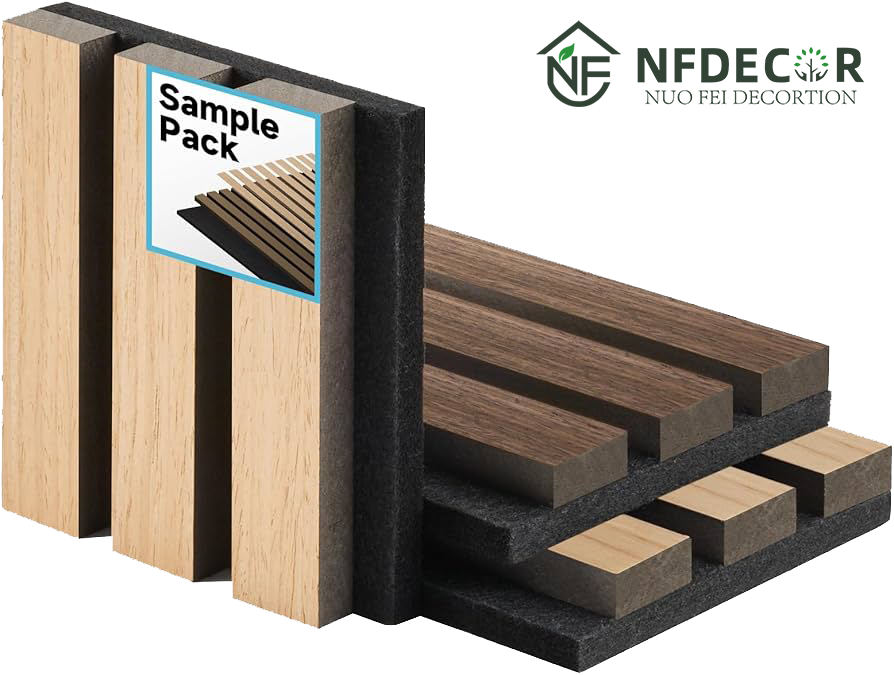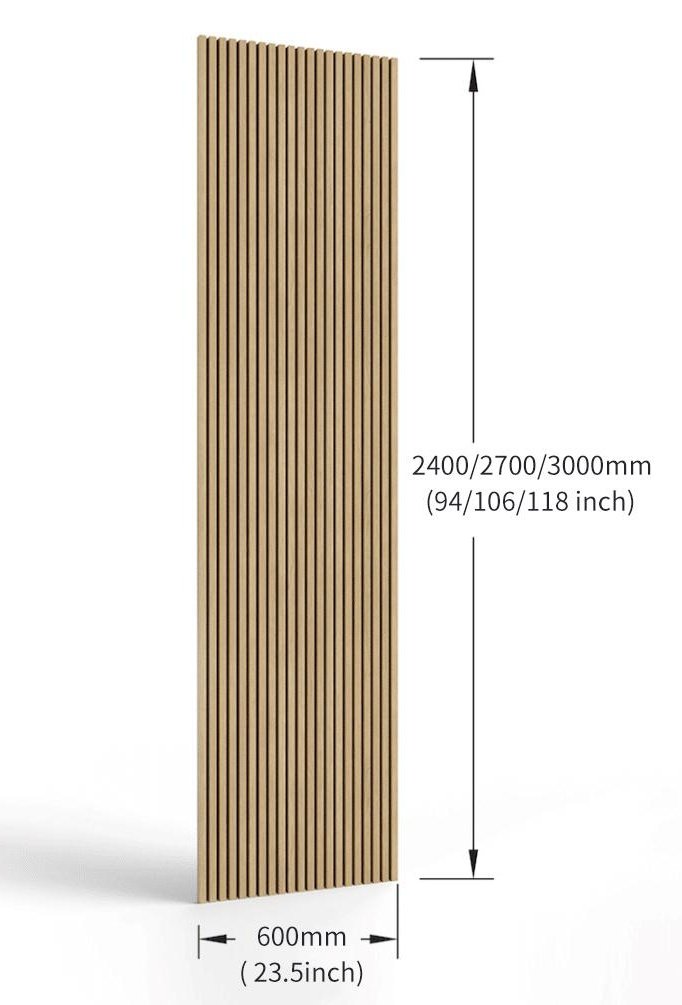Noise ruins focus. In open offices or busy restaurants, it’s hard to think straight. Wooden acoustic panels cut the chaos, bringing calm to your space.
Wooden acoustic panels absorb sound, reduce echoes, and enhance aesthetics. They improve speech clarity, boost privacy, and add natural warmth. Perfect for offices, studios, or homes, they transform noisy spaces into quiet, stylish havens.

wooden acoustic panels in modern space
I’ve seen it myself—clients rave about the difference. Stick around, because I’m breaking down why wooden panels are a game-changer for your space.
What Are the Benefits of Acoustic Wood Panels?
Acoustic wood panels seem pricey. But the perks? They’re worth every penny.
Acoustic wood panels reduce noise, improve sound quality, and elevate design. They cut echoes, enhance privacy, and add a touch of nature. Ideal for any space craving both function and style.

Let’s break it down. Sound absorption comes first. Wooden panels soak up noise, making spaces quieter. I installed them in a client’s open office once—echoes vanished, and focus improved. Next, aesthetics. Wood adds warmth and texture. Mark, a distributor in Canada, put our panels in his showroom. His clients couldn’t stop talking about the look. Then, versatility. These panels fit offices, homes, studios—anywhere. Finally, eco-friendliness. At NF Decor, we use sustainable wood. It’s good for the planet and your brand.
Here’s a quick look:
| Benefit | Why It Matters |
|---|---|
| Sound Absorption | Cuts noise, boosts focus |
| Aesthetics | Adds warmth and style |
| Versatility | Fits any space |
| Eco-Friendly | Sustainable and responsible |
I’ve shipped panels to the USA, UK, and beyond. The feedback is always the same: they work, and they look great. Installation is easy too. Our panels at NF Decor come with simple mounting systems. Mark’s team set them up in a day—no fuss. They’re durable as well. Real wood lasts years, unlike cheap options that warp or fade. I stand by quality, and you should too. At a trade show in Germany, a client didn’t believe wood could handle heavy noise. I showed him our test reports—NRC ratings above 0.8. He ordered right there. That’s the power of proof.
Why Is Wood Good for Acoustics?
Wood seems too simple. Can it really tame sound? I’ve wondered that too.
Wood is porous, which helps it absorb sound waves. It reduces echoes and improves clarity. Plus, it looks natural and timeless—perfect for modern spaces.
Wood’s natural structure makes it a sound absorber. Its fibers and pores trap sound waves, turning noise into heat. I figured this out running my factory in China, testing different woods for performance. Oak and walnut do well, but at NF Decor, we use engineered wood for consistency. It’s reliable every time.
Here’s how it stacks up:
| Material | Sound Absorption | Aesthetics |
|---|---|---|
| Wood | High | Natural, warm |
| Fabric | Medium | Soft, varied |
| Foam | High | Basic, cheap |
Wood beats others in looks and performance. A client in Australia swapped foam for our wooden panels. He said the space felt richer, and sound got better. That’s why I push wood—it’s the full package. Wood diffuses sound too. Its uneven surface scatters waves, stopping harsh echoes. In studios, this is key. A UK producer told me our panels cleaned up his mixes—no more muddy sound. The thickness matters too. Thicker panels catch lower frequencies. At NF Decor, we offer different sizes. Mark in Canada swears by our 2-inch panels for bass-heavy rooms. It’s practical and effective.
Is Wood Paneling Good for Soundproofing?
Soundproofing confuses me. Does wood really block noise, or just absorb it?
Wood paneling absorbs sound within a room but doesn’t fully block external noise. For soundproofing, you need mass and isolation. Wood helps, but it’s not a complete solution.

wood paneling and soundproofing
Let’s clear this up. Sound absorption cuts noise inside a space—like echoes or chatter. Soundproofing stops noise from coming in or going out. Wood panels are great at absorption, not soundproofing. In Mark’s showroom in Canada, our panels made conversations clearer. But street noise still crept in. Blocking that needs heavy stuff like concrete or special barriers.
Here’s the difference:
| Function | What It Does | Best Materials |
|---|---|---|
| Sound Absorption | Reduces internal noise | Wood, fabric, foam |
| Soundproofing | Blocks external noise | Concrete, mass-loaded vinyl |
I tell clients to use wood for acoustics and add other fixes for soundproofing. A construction company in France paired our panels with insulated walls—perfect combo. Wood can help soundproofing a bit if you layer it thick. But alone, it’s not enough. I told a client in Malaysia to add double-glazed windows with our panels. He slept better at night. Soundproofing needs mass, damping, and separation. Wood gives some mass, but you need more. At NF Decor, we focus on absorption. Still, I’m happy to guide you on full solutions.
What Are Acoustic Panels Good For?
Acoustic panels sound technical. What do they actually do for me?
Acoustic panels reduce noise, improve sound quality, and enhance privacy. They cut echoes in offices, clarify sound in studios, and add style to homes. They’re versatile and effective.

uses of acoustic panels
Acoustic panels have lots of uses. First, noise reduction. In open offices, they quiet chatter and boost focus. Mark put them in his Canadian office—productivity jumped. Second, sound clarity. In studios or theaters, they stop echoes, making audio sharp. A German client used our panels in his home cinema. He said it felt professional. Third, privacy. In shared spaces, they soften conversations. A USA law firm added panels to meeting rooms—clients felt safer talking. Fourth, aesthetics. They beat bare walls or ugly foam. Our 3D felt panels are a hit in Australia—modern and useful.
Here’s a rundown:
| Use Case | Benefit |
|---|---|
| Offices | Boosts focus, reduces noise |
| Studios | Clarifies sound, cuts echoes |
| Homes | Adds style, improves acoustics |
| Public Spaces | Enhances privacy, looks good |
I’ve seen it up close. At trade shows, clients touch the panels and picture them in their spaces. It’s exciting. I helped a UK school once. Their gym echoed so much the kids couldn’t hear. Our panels fixed it. The principal thanked me in person. That’s why I do this.
What Are the Pros and Cons of Acoustic Wall Panels?
Acoustic panels aren’t perfect. I’ve had clients ask—what’s the catch?
Pros: reduce noise, improve aesthetics, easy to install. Cons: can be pricey, may not block external noise, and require maintenance. Still, for most spaces, the benefits outweigh the drawbacks.
Pros come first. One, noise reduction. They cut echoes and chatter, making spaces calm. Two, style. Wood or felt panels look high-end. Three, versatility. They work in all kinds of rooms. Four, easy setup. Most panels go up fast. Now, cons. One, cost. Good panels aren’t cheap. Mark says you get what you pay for, though. Two, limited soundproofing. They absorb, not block. Three, upkeep. Dust builds up, so you need to clean them. Four, space. Thick panels take room, but we have slim ones too.
Here’s a table:
| Pros | Cons |
|---|---|
| Reduces noise | Can be expensive |
| Improves aesthetics | Doesn’t block external noise |
| Easy to install | Requires maintenance |
| Versatile | Takes up space |
I tell clients to think about their needs. Usually, the pros win. A client in Malaysia worried about price. After setup, he said it was his best office upgrade. Fading can happen too. Some panels lose color over time. At NF Decor, we use UV-resistant finishes to fix that. Installation errors are another issue. I saw panels put up upside down once—funny, but useless. Good instructions matter.
Do Acoustic Panels Reduce Street Noise?
Street noise drives me nuts. Can acoustic panels fix that, or am I stuck?
Acoustic panels reduce internal noise but don’t fully block street noise. For that, you need soundproofing solutions like insulated walls or windows. Panels help, but they’re not a silver bullet.

Street noise is tricky. It’s low and constant. Acoustic panels handle mid to high sounds well, but low bass slips through. For traffic or construction noise, panels alone won’t do it. You need a mix. Add mass-loaded vinyl behind walls or get double-glazed windows. I told a USA client to try both—panels for inside, soundproofing for outside. It worked great.
Here’s a plan:
| Noise Type | Solution |
|---|---|
| Internal (echoes) | Acoustic panels |
| External (street) | Soundproofing materials |
Mark in Canada had this problem. His office sat by a busy road. We added panels and suggested window fixes. Noise dropped a lot. He was happy. Seal gaps too. Doors and windows let sound in. Weatherstripping helps. Rugs or curtains add more quiet. At NF Decor, our outdoor panels look nice but don’t stop heavy noise. Panels are a piece of the puzzle. I say hit noise from all sides—your ears will thank you.
Conclusion
Wooden acoustic panels cut noise, boost style, and fit any space. At NF Decor, I’ve seen them transform rooms worldwide. Ready for calm? Reach me at lillian@nfdecor.com.










